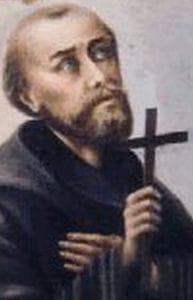Saint John Roberts
Saint
Feast Day: December 10
Death: December 1, 10
Biography
Saint John Roberts, also known as Saint John Roberts of Trawsfynydd, was born in 1577 in Trawsfynydd, Merionethshire, Gwynedd, northern Wales. He was the son of John and Anna Roberts, and his ancestors were princes in Wales. Although raised Protestant, John always felt a deep affinity for Catholicism. He pursued his education at Saint John's College, Oxford, from 1595 to 1597, but left without obtaining a degree. Following this, he studied law at the Inns of Court when he was 21 years old. In 1598, while traveling in France, John had a transformative experience. He joined the Church of Rome at Notre Dame in Paris, indicating his conversion to Catholicism. Seeking to further his studies and discern his vocation, he entered the English College at Valladolid, Spain, on 18 October 1598. However, he left the College in 1599 to pursue his calling as a Benedictine monk. John joined the Abbey of Saint Benedict in Valladolid and became a Benedictine novice at the Abbey of Saint Martin in Compostela, Spain, in 1600. In due course, he was ordained a priest while at the abbey. Following his ordination, Father John returned to England in the role of a missioner. He departed on 26 December 1602 and entered the country in April 1603. Unfortunately, he was arrested in May 1603 and subsequently exiled. Nevertheless, he returned to England in 1604, where he fearlessly dedicated himself to serving plague victims in London. However, he was arrested again and banished from the country. Undeterred, John returned to England once more in 1605. However, during a search for individuals suspected of involvement in the Gunpowder Plot, he was found at the home of Mrs. Thomas Percy and arrested yet again. Although he had no connection to the plot, he spent seven months in prison before being exiled once more in July 1606. During his subsequent exile, he established a house in Douai for exiled English Benedictines, which eventually became the renowned monastery of Saint Gregory. It was during this time that he played a pivotal role in the conversion of Blessed Maurus Scott. In October 1607, Father John returned to England once more; unfortunately, he was arrested in December and sent to Gatehouse prison. However, he managed to escape and spent a year working in London, tirelessly ministering to the faithful. However, he was apprehended once more, and his execution was initially scheduled for May 1609. Thanks to the intercession of the French ambassador, his sentence was reduced, resulting in yet another exile. Despite these difficulties, Father John returned to England a few months later. However, on 2 December 1610, while he was celebrating Mass, he was arrested once more. He was quickly convicted of the crime of priesthood on 5 December 1610. Alongside Blessed Thomas Somers, he embraced martyrdom. Saint John Roberts was hanged, drawn, and quartered on 10 December 1610 at Tyburn in London, England. His body was initially taken to Saint Gregory's in Douai, France. However, it disappeared during the French Revolution. Today, two of his fingers are preserved at Downside Abbey and Erdington Abbey. Saint John Roberts was venerated on 8 December 1929 by Pope Pius XI through a decree of martyrdom. Pope Pius XI beatified him on 15 December 1929, and later, on 25 October 1970, Pope Paul VI canonized him. He is recognized as one of the Forty Martyrs of England and Wales. Although he does not have a specific patronage assigned to him, he is a revered figure in the Catholic Church, embodying faithfulness, courage, and dedication to the Catholic faith.
